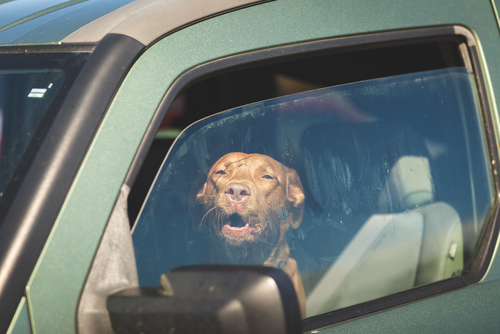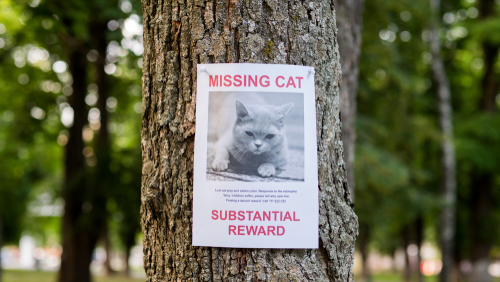
Summer is a great season to get out and enjoy time with your pet. However, certain situations can put your pet at risk if you don’t take some precautions. Our team at Livermore Family Pet Hospital would like to ensure your pet stays safe by explaining scenarios that pose a threat to them.
Unsafe pet scenario #1: “Bailey the beagle went with their owner to run errands. The owner left Bailey in the car while he ran into the store to pick up bread, but he parked in the shade and left the window cracked open. Bailey quickly became overheated and collapsed. Luckily, after a few days in the hospital receiving intravenous fluids, Bailey fully recovered.”
Your pet is extremely susceptible to heatstroke because they cannot sweat, and must rely on panting and outward cooling sources to bring their body temperature down. Normal body temperature for your pet is 100 to 102.5 degrees. If their temperature reaches 105, they are at serious risk for heatstroke. Signs of heatstroke include excessive drooling and panting, lethargy, vomiting, diarrhea, seizures, and collapse. Senior pets, overweight pets, and pets suffering from a heart or respiratory issue are at higher risk. You can prevent your pet from suffering a heatstroke by taking the following precautions:
- Hydration — Dehydrated pets are more prone to heatstroke so ensure your pet has access to water and stays hydrated.
- Exercise — Strenuous exercise should be avoided on hot, humid days. When taking your pet for their daily walk, try to go during the cooler periods of the day.
- Vehicles — Never leave your pet unsupervised inside a parked car. Parking in the shade or leaving the window cracked open does not compensate for extreme temperatures.
- Indoors — Keep at-risk pets inside in the air conditioning on hot, humid days.
- Hot paws — Asphalt can become extremely hot and can burn your pet’s sensitive paws. Stay on grassy areas when walking, or protect their feet with pet booties.
Unsafe pet scenario #2: “Deborah the Doberman was enjoying an afternoon cookout and was thrilled after scoring an entire plate of hamburgers. However, Deborah was not feeling so happy later when she started vomiting and had diarrhea. Deborah’s stomach remained upset for several days, and she will not make that mistake again.”
Cookouts pose several risks for your pet. Any sudden change in diet can lead to stomach upset, and foods high in fat can lead to pancreatitis, a serious and painful condition. Several common foods, such as onions, garlic, and chocolate, can be toxic to your pet. Other factors to consider include the possibility that your pet will ingest a foreign body, such as cooked bones or plastic wrap. Keep all food and garbage in sealed containers to prevent an accident from occurring.
Unsafe pet scenario #3: “After a day wandering off the beaten path, Junior the Jack Russell developed excessive nasal discharge and could not stop sneezing. Junior’s owner took him to the family veterinarian who found a foxtail buried in his nose. The veterinarian was able to remove the offending object, and Junior will be more careful where he sticks his head in the future.”
The foxtail plant has barbed seed heads that can burrow their way into your pet. Common problem areas include:
- Feet — Foxtails can easily become embedded between your pet’s toes. If your pet is limping or licking their feet, check them for foxtails.
- Ears — If a foxtail is in your pet’s ear, they will shake their head and scratch incessantly at the affected ear. The seed head may burrow deeper than you can see and require a visit to your veterinarian.
- Eyes — Foxtails affecting your pet’s eyes will cause redness, discharge, swelling, squinting, and rubbing. Your pet will need immediate veterinary attention if they are displaying these signs.
- Nose — Foxtails can migrate from inside your pet’s nose to their brain if not removed. Signs include excessive sneezing and nasal discharge.
The best way to prevent your pet from being affected by foxtails is to keep them out of overgrown grassy areas, remove foxtail plants from your yard, and trim your pet’s coat if they tend to get foxtails frequently. You can also purchase a foxtail hood, which will be sized to fit your pet.
Unsafe pet scenario #4: “Sarah the Siamese became so upset during the local festival’s fireworks celebration that she ran away. Sarah’s owner had recently had her microchipped, so she was returned after a few days.”

Sudden loud fireworks noises can cause extreme anxiety for some pets. Steps to help keep your pet safe include:
- Identification — Ensure your pet has accurate identification tags and consider having them microchipped.
- Make a safe zone — Keep your pet inside in an interior room or crate to ensure they cannot run away. You can leave music playing to help mask outside noises and provide food-puzzle toys to distract them.
- Behavior modification — You can try desensitization and counterconditioning training to help them cope.
- Medications — If your pet is overly stressed, ask your veterinary professional if anti-anxiety medications or sedatives would help them.
Do not let an unsafe pet scenario ruin your summer fun. If your pet has a mishap while enjoying a summer day, do not hesitate to contact our team at Livermore Family Pet Hospital.

